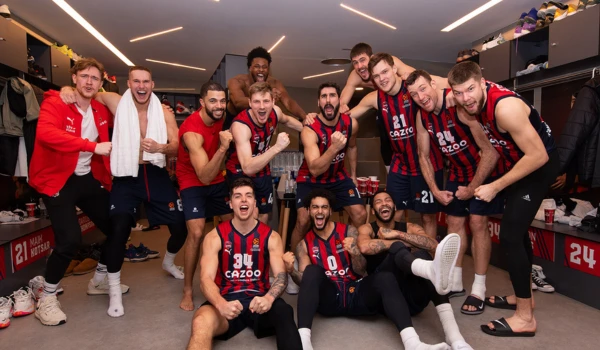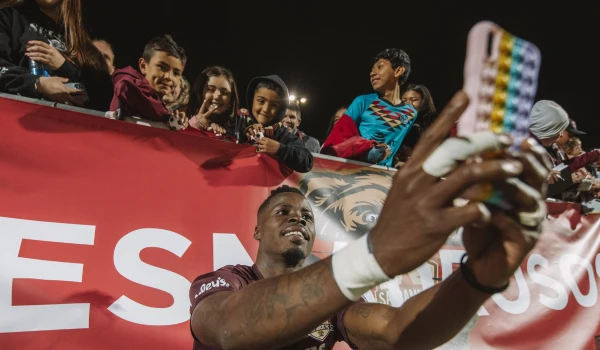Introduction
Ten years ago, your average fan pulled on their favourite jersey, got in their car, drove to the stadium, and visited the concession stand pre-game for a snack and once the game ended, maybe listened to the radio on their way home. Today, the sports wheel is never ending, whether arguing about the referee who has been appointed a week before the game or laying out the statistics to showcase that player X needs to start the next game, fan engagement has entered a new era. From the moment the lineups get announced on Twitter, up to the best clips of the most popular hosts on the broadcast in the post-match analysis, fans are engaging with their clubs on another level, and on several devices. Clubs cannot sit idle any longer.
We asked ourselves several key questions, which shall guide our thought process throughout. The first is to examine the importance of a club having one single accessible hub where they can have all their assets and distribute them to their various stakeholders (content team, players, sponsors, partners etc.). The second is how we can evaluate the value of distributing these assets at a consistent rate to their key stakeholders and ambassadors and whether brand amplification is possible through content creation. Thirdly, with the help of our customer success stories we wanted to examine the best solution to these problems.
A new digital media landscape
The current status quo
The current digital media management landscape in sports, much like many aspects, trails similar entertainment industries. The ecosystem is made up of several stakeholders, with clubs, players, sponsors, partners, and fans. Each week, huge swathes of assets are created, pushed, stored, posted, sent and yet, the processes remain ineffective and waste valuable resources. Many sports organisations have archives stored on hard-drives, DVD, USB – name an old-fashioned way of storage, and some club, somewhere, will be using it. When it comes to sharing their assets with their players the workflow is slow. Post-match, the photographer might upload their photos onto Getty Images, or on Google Drive, so that the social media team can access and edit them. Then, after hours of searching for the best assets, and being flooded with WhatsApp messages from the players asking for their best shots, the team finally begins the painful process of sending shareable links, WeTransfers, WhatsApps, before creating folders and choosing assets for their numerous sponsors and partners.
Time is wasted. Resources are wasted. Most of all, opportunities are wasted. Realizing the power of their assets, and the desires of their fans, will be a defining difference between organisations who expand their fanbase and brand among digital natives, and those who fall behind as they miss the digital boat.
Thesis
Sports clubs around the world need to centralise their content and automate their distribution to their stakeholders and ambassadors. The combination of these elements will result in organic brand amplification at scale. In an era where fan displacement is the norm engaging with fans who won’t be present in your stadium every weekend is essential.
Trends
Despite the ever-decreasing effects of the pandemic on the world compared to two years ago, its effects will be long-lasting in terms of the acceleration of the sports industry’s digitalisation. The pandemic accelerated this digital transformation as organizations raced to find solutions to fanless stadiums and an increase in online viewership. It started with cardboard cut-outs, then moved to whole screens with fan faces, and online FIFA tournaments for the stars we were so used to seeing on the pitch. Change was coming, but this was a stark reminder to club finances that they needed to further engage their fanbase, and that this meant more than only on matchdays or in stadiums. Indeed, event-related content no longer serves the full needs of the community, as sports organizations of all sizes are now media brands which are producing regularly scheduled programming such as Amazon’s All or Nothing series, or Netflix’s Drive to Survive. Clubs such as Real Madrid and Wolverhampton Wanderers are expanding into the entertainment industry, or rather, expanding their portfolio in the entertainment industry; sport after all, has always been entertainment. Some understand this better than others.
Furthermore, social media growth means digital natives’ content consumption is quickly evolving as short-form content takes the upper-hand and old giants such as Meta (formerly Facebook) are having to find new ways to engage their audience. Gone are the days of sports organisations having their Facebook page as their main point of contact, with successful organisations’ content strategy now involving Instagram, Snapchat, TikTok, YouTube and Twitter.
From the macro to the micro, we’ve seen how social media are continuously growing and clubs are having to adapt to this next step in digitalisation, but the industry itself already has some of the biggest influencers in its midst. Athletes drive a portion of social media growth because of their innate follower loyalty and consistent exposure. They represent powerful variables in any sporting organisation’s marketing strategy as they are essentially influencers already on their payroll. Signings and transfers away have caused huge increases and decreases in following as Gen Z and Alpha follow athletes almost as loyally as others do clubs
For content's sake
Managing content
Fans’ insatiable appetite for content means organisations need to manage the treasure trove of content they produce daily. As this volume increases, and the number of club channels increases with different dimensions, styles, tones, and character limits, it becomes ever more important to get ahead of managing the final product assets that represent the brand’s online presence. Scaling this process means scaling the efficient storage methods that offer instant retrieval, so more time is spent on content creation and less on searching for the right asset. To maximize their ROI, sporting organizations need to prioritize the creative side of their content team and eliminate wasted resources and solve their ever-growing bottlenecks. This process does not just reap rewards now, but further down the line when clubs can repurpose assets to celebrate their history and past achievements and legends.
Content workflows
Content workflows vary from club to club based on resources. Here we outline three layers of possible of workflows, and how these can be optimized no matter the size of the organisation.
Small organisation: limited resources and personnel
1. Contracted photographer for key events (primarily for matches)
2. Day to day management of social engagement across social media accounts
3. Low-cost and easy-to-produce video content
Deficiency: traditionally missing distribution
Medium organisation: some resources and personnel
1. Full-time photographer, and contracted videographer for key events with some full-time digital staff
2. Every day social media management to foster community
3. Well-structured video content, decent calendar of events with players and partners
Deficiency: inconsistent distribution and hardly customised for players
Large organisation: resources and personnel
1. Plenty of full-time creative staff
2. Every day social media management to foster community
3. Well-structured video content, completely full calendar of events with players and partners
Deficiency: missing automation meaning wasted resources and personnel
The ideal content workflow does not necessarily involve a large team, or huge resources, but the automation of several processes leaves more time and resources for the aspects that cannot be automated. The automatic centralisation and distribution of assets allows organisations to concentrate their resources on creation and the creative side of expanding their community.
Content standards
The standards for a well-run sporting organisation now go far beyond performance on the pitch. The pandemic, social movements and looming climate issues have shown that organisations need to be able to showcase that they are equipped to meet ESG requirements, actively participate in their community when they can, and pivot their local strategy to adapt to increasingly displaced fans all over the globe. These standards go together with an adapted content strategy to continuously provide their online community with updates and entertainment through carefully chosen and crafted assets. The combination of Dropbox, Google Drive, WeTransfer, and WhatsApp is not sustainable anymore and the increased demand for real-time content makes such slow storage methods untenable. The impact that user error can have at scale for these antiquated methods makes them even more detrimental to continue using in the long run. Every event, whether training session, press conference, charity event or sponsor promotion, is an opportunity for fans to join along through digital content and become further connected to the organisation. Distribution within minutes and having a method that scales over a long period solves these issues and plants organisations at the forefront of being able to engage their increasingly digitally native fanbases. Moreover, athletes are increasingly aware of their brand image and put immense pressure on contact teams to get great personal branding contact as soon as possible.
Brand amplification
KPI formula for digital progress
PwC contend that sports organisations need to follow a certain KPI formula for digital progress which will allow them to amplify their brand:
1. Increase fan reach by generating good content online
2. This strategy will lead to increased engagement
3. Subsequently, incorporate relevant brands into the content, thereby increasing the commercial effect of the digital assets.
Fans remain the ultimate content consumer, as they will consume through the pain of losing titles the same as they do when they win. There is no consumer more loyal than the sports fan, who’s brand loyalty does not come from the product, merchandise, or marketing, but rather an innate connection to their club. Unparalleled loyalty. The more quality content provided, the stronger the displaced online fan community, founded upon local values. Clubs, their stakeholders and ambassadors do of course all benefit from collective brand exposure, and amplification means acting in the moment so that ambassadors and clubs can have their assets quickly. However, passive exposure is only the first step in the process, and the ability to activate the fanbase means that users come for the content, and remain part of the community for the experience, therein lies the value of community building through content.
Brand consistency
Much like any brand, amplification demands consistency. In the highly developed digital world, consistency is synonymous with reputation. Every asset produced by an organisation, whether physical or digital plays a part in its repute and aligning them fosters a sense of both confidence and trust in the brand. Whether it is posted by the club, its players, or its sponsors, the content needs to be high quality and ready to post. Despite most players now being digitally native, they are still not social media experts. The easier it is for them to share top content, the more every stakeholder benefits.
The value of this brand consistency and amplification may not be easily immediately calculated in financial metrics or ROI, however meaningful engagement and exposure over the long-term will foster an international fan-base offering further opportunities for sponsors, partners, and events. The organisation’s ability to easily store and distribute media assets contributes hugely to this strategy, and over the years assets can be repurposed for all types of mediums, whether social media, club documentaries or compilations.
A simple ScorePlay solution
ScorePlay is a media asset management software made specifically for the sports industry. It helps brands be their best online selves and specialise in workflow optimisation for some of the biggest sporting brands in the world. Made up of a team of experts on a variety of workflows within the sporting pyramid, ScorePlay has built solutions that drive a return on media asset investment previously never seen.
The software allows sports organisations to upload and centralise their media assets on one platform, where the AI labels every asset with the relevant ‘tag’ (players, opponents, sponsors etc.), so that they can be easily searched, accessed and distributed. It also allows photographers and videographers to feed assets directly from pitch to platform, instantly. Real Sociedad wanted their photographer to be able to transmit the assets they were capturing directly from their on-pitch camera to the content team. Their wish was granted with direct FTP connection, where assets are fed directly into the ScorePlay app, where they can be accessed by the content team on the platform.
The Athlete app allows players to immediately access all the assets they have been tagged in, saving content teams hours of needless admin work. Orlando City use the Athlete App so that all their players can instantly access all their assets and post soon after the game. Their most famous player? Alexandre Pato. When he scored his first goal for the club in February 2022, he was able to post 10 minutes after full-time and get 100,000 likes. His following is 10 times that of the club, a true ambassador that needs to be taken advantage of. Simple with the Athlete app. Partners, meanwhile, benefit from a streamlined process so that more value is immediately added to any partnership, as they can access their assets through the platform.
The bottom line is that centralising and distributing high quality content will amplify your brand and increase connectivity with your fans. By automating the delivery of content to players, you harness their social network in the moment and receive secondary engagement that can be directly traced back to your brand. Increased reach to your target audience will have a direct correlation with increased revenue over the long-term. Those who do not get in front of asset management will pay the price down the line with wasted resources and inefficient workflows, with competitors gaining an online edge which is fast becoming extremely correlated to commercial success.
The next step in fan engagement is to provide supporters with valuable experiences in the places they already interact. Club-owned platforms, despite many attempts, are not attractive because of the further step and separate application away from the wider community. Meanwhile, financially opportunistic strategies such as Socios.com face backlash from fans who dedicate their lives to an organisation and feel mistreated as mere customers. ScorePlay is taking lessons from the creator economy where frictionless access means a mobile-first, no download needed and direct from social-media launched experience. Links in social media bios can give access to authentic gamified interactions where building a community is the priority over monetisation. This next step in our evolution will provide organisations with easily tailored UGC campaigns, mini-games, prediction challenges, social forums, and increased feeling of fan community. OGC Nice recently had a user-generated content campaign where they created a WhatsApp group for fans to upload their UGC during their cup run to the French final. With ScorePlay’s future solution, Nice could execute this campaign at scale and create thrilling stories while engaging their fans on their journey. They’re not alone either. Clubs all over the world are joining the media revolution and contributing ideas to how the best media asset management software for clubs should be.
About ScorePlay
ScorePlay is your best-in-class media solution that provides an automated architecture to centralise, distribute, and classify your digital assets, whether photos, videos, or live broadcasts. We are transforming sports organizations, automating their creative processes and growing their brands and unlocking new revenue. We are the bridge to the future of sports storytelling, from content capture to fan consumption. Automate. Grow. Unlock.
Credits
Photo credit: AS Monaco




